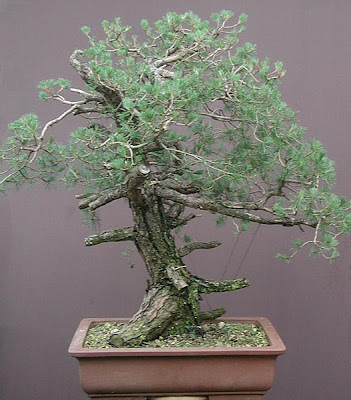In April of 2001 the pine was finally harvested. The rootball is still quite small for this huge tree, but the crown is quite healthy and dense. It can be clearly seen that there was a second trunk at the base which went down to the ground and was cut off. At that point in time I decided to make this a fake fat root to get a very impressive nebari. One problem with collected Scots pine is that they very rarely have a decent nebari.





In July of 2007 it was decided to finally give this tree the big first styling. First the crown was edited again and all the old needles were plucked.



All the stumps were jinned and it looks terrible. Will this ever become a good bonsai?




David wired for several days. Finally the pine looks decent and seems to have a grand future.





The wire had to be taken off in fall of 2005. As expected and normal on Scots pines most branches went back into the old position and many new ones developed more and more green at the ends, became heavy and started to hang down like a weeping willow. A Scots pine in this stage looks like it will never become a decent bonsai. In May of 2007 I had some help and we took the tree out of the large container and planted it into a much smaller one made by Derek Aspinall. Then the crown was edited, and the old needles were plucked. What was supposed to look like a fat root but really was the stump of a second trunk was cut back and made into a very ugly jin. What was I thinking? Well, wait and see.










The tree was left alone and set around in a rather pathetic state for two years. Finally, in the beginning of July, 2009 all old foliage was plucked and it looked somewhat like a natural tree. But this is not good enough, of course. The deadwood still looks grotesque and crude and the crown needs a lot more refinement. Naturalistic style does NOT mean to leave things to nature. Quite the contrary. it only should look like nature did it all in the end.




The deadwood now had enough time to really dry within the past three years. it looks very crude, unrefined, man made. Some folks may have wondered what I was doing her exhibiting such ugly stumps in my garden. Well, bonsai is a long term process. Now is the time to refine.I went over most stumps again with a dremel type die grinder and very small bits. Then the tree was placed so that I could apply the torch and the heat would go up into the air and not burn some live parts. As one can see In actually set fire to some parts of deadwood. Afterward the charcoal is brushed off with hard strokes of a brass brush.













Now the crown was edited slightly, meaning some branches got cut back. Then the long wiring session starts which takes more than a full day. First all thicker branches are wired and put into position. When this is finished I have a rough sketch where I can see very well what it will look like. If i like it I continue and ire EVERYTHING. Every little branch gets wired! I take copper wire only and thicker than most folks. I want the branches to stay where they are regardless of whether a bird sits on them, a thunderstorm comes through or snow gets on it in winter.







Now the tree is finished for the time being. The wire will probably have to go off next summer and I may have to rewire again. As it should be with a bonsai in the naturalistic style it looks like a credible tree from all angels.









NSC_7931vr is a virtual. although I like it form many angels I think this is the best front. so I placed the pot underneath to see what it will look like next spring.

Most artists would paint the deadwood with lime sulphur now to make it whit like it 'has' to be with a good bonsai. I do nothing like this. This is a statement! Natural deadwood is not always white it can well be dark like this one. I will not paint this to make it look unnatural.


A big problem with naturalistic bonsai is that they seem to be so dense and untidy on a photograph while in reality they are rather sparse and very natural, but not untidy. They have powerful three-dimensionality with back branches which can be seen through holes in the front. On photographs this look like an untidy mess. One solution is to show the trees against a very light background. Thus the crown appears much more sparse.

